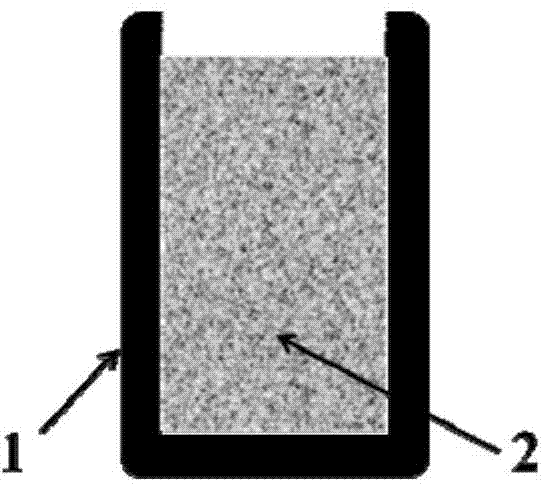Composite electrode material for lithium-sulfur battery anode and preparation method thereof
A composite electrode and electrode material technology, which is applied to battery electrodes, circuits, electrical components, etc., can solve the problems of active material sulfur loss and sulfur loss, and achieve the effects of reducing impact, low cost, and improving utilization rate
- Summary
- Abstract
- Description
- Claims
- Application Information
AI Technical Summary
Problems solved by technology
Method used
Image
Examples
Embodiment 1
[0039] Mix sulfur and Super P carbon powder in a ball mill tank with a mass ratio of 3:1, and then keep it in an argon-protected tube furnace at 155 degrees Celsius for 2 hours to liquefy the elemental sulfur and enter the pores constructed by the carbon powder , to obtain carbon-sulfur complexes.
[0040]Blend it with polytetrafluoroethylene emulsion (PTFE, 5% mass fraction) in ethanol to obtain electrode slurry, in which the mass ratio of the compound to polytetrafluoroethylene is 4:1, and the ratio of solid matter to solvent It is 20mg solid / ml solvent; the sheet electrode is prepared by rolling, and dried at 60 degrees Celsius, wherein the sulfur density is 3mg / cm 2 .
[0041] The electrode obtained by the above process is used as the positive electrode to prepare and assemble the lithium-sulfur battery, and discharge at 0.1C to convert the elemental sulfur into lithium sulfide; under an inert atmosphere, the discharged positive electrode is cleaned with ethylene glycol d...
Embodiment 2
[0046] The composite of carbon and lithium sulfide was prepared by the same process as in Example 1, and the carbon material was KB300.
[0047] The above compound is placed under an argon atmosphere, the argon flow rate is 30ml / min, acetylene is the carbon source, the flow rate is 15ml / min, at 900 degrees Celsius, vapor deposition for 2 hours, and naturally cooled to room temperature; Composite electrode material. The positive electrode for lithium-sulfur batteries was prepared by the same process as in Example 1, wherein the composite areal density was 4 mg / cm 2 .
[0048] Assemble a lithium-sulfur battery, charge and then discharge at 0.1C, 100 cycles, the capacity retention rate is 78%.
Embodiment 3
[0050] The composite of carbon and lithium sulfide was prepared by the same process as in Example 1, wherein carbon nanotubes were selected as the carbon material.
[0051] The above compound is placed under an argon atmosphere, the argon flow rate is 30ml / min, benzene is the carbon source, the flow rate is 0.2ml / min, at 900 degrees Celsius, vapor deposition for 2 hours, and naturally cooled to room temperature; composite electrode materials. The positive electrode for lithium-sulfur batteries was prepared by the same process as in Example 1, wherein the composite areal density was 4 mg / cm 2 .
[0052] Assemble a lithium-sulfur battery, charge and then discharge at 0.1C, 100 cycles, the capacity retention rate is 80%.
PUM
| Property | Measurement | Unit |
|---|---|---|
| melting point | aaaaa | aaaaa |
| boiling point | aaaaa | aaaaa |
| quality score | aaaaa | aaaaa |
Abstract
Description
Claims
Application Information
 Login to View More
Login to View More - R&D
- Intellectual Property
- Life Sciences
- Materials
- Tech Scout
- Unparalleled Data Quality
- Higher Quality Content
- 60% Fewer Hallucinations
Browse by: Latest US Patents, China's latest patents, Technical Efficacy Thesaurus, Application Domain, Technology Topic, Popular Technical Reports.
© 2025 PatSnap. All rights reserved.Legal|Privacy policy|Modern Slavery Act Transparency Statement|Sitemap|About US| Contact US: help@patsnap.com


